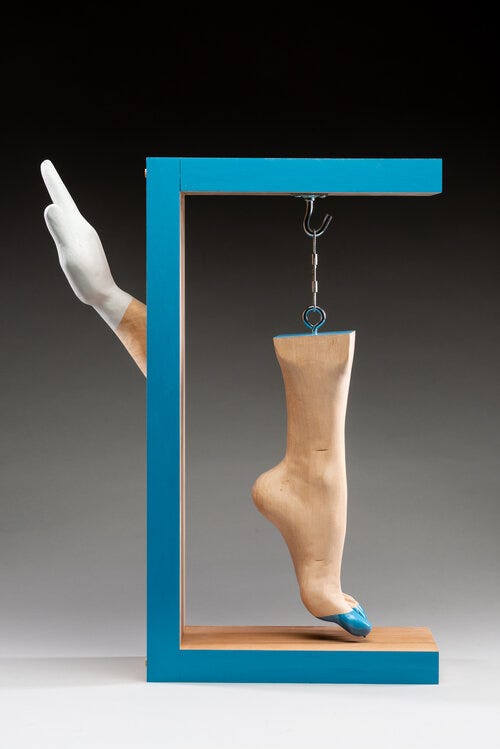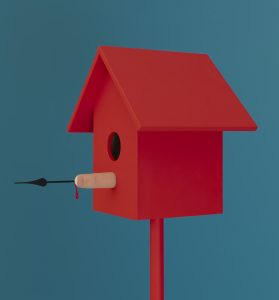Words's Worth
Text-based art in "Required Reading," a 10th-anniversary celebration at Otis Street Arts Project, and solos by Langdon Graves and Isabella Whitfield
Anne Barnes, “Altered History” (Workhouse Arts Center)
IN THE BEGINNING WAS SOME SORT OF WORD, or at least individual letters. Not all the artworks in "Required Reading" are legible, but each involves some aspect of writing or typography. The Workhouse Arts Center exhibition presents pieces by eight mostly local artists who seek to find meaning in words -- even if that's by obliterating them.
Curator-participant Michele Montalbano assembled the show almost entirely from preexisting works, so regular visitors to local galleries may recognize some of them, or at least their makers's trademark strategies. The tactics can be as personal or detached, respectively, as that of the two artists who utilize typed text: Julia Bloom, whose single-color drawings incorporate entries from her diary, or Scott Hazard, who reiterates pairs of words on sheets of paper layered to construct grotto-like dioramas.
The text in Hazard's wood-and-paper sculptures is entirely legible, but such words as "terrain," repeated hundreds of times, are subsidiary to the topographic minimalism. Bloom's diary excerpts are densely typed over each other, so they're hard to decode as anything other backdrops for the elemental circles and semicircles Bloom draws over them.
The words are just as present and just as illegible in Anne Barnes's "Altered History," an art-history textbook in which she's painted over all the references to male artists. There's not much left to read, save for the exuberance of Barnes's multi-color rebuke.
Comprehending Leslie Holt and Emily Fussner's message is a little trickier. Holt makes stain paintings that she embroiders on the back with phrases related to mental health. The words can't be read on the front, but the pictures are hung so the flip sides can be inspected. Fussner's poetic text about light and shadow is laser-cut into tinted translucent acrylic so it can best be read when sunlight casts it on a nearby surface.
Letters and other linguistic symbols are primarily graphic elements in the other three participants's work. Kate Fitzpatrick stitches white pages or panels with either red or black thread, emulating the visual sense of text without the logic, and offers a towering "Word Fall" of cut white-paper letters on near-invisible wires. Similarly, Ying Zhu hangs a three-ply curtain of letters, black rather than white. As in Fussner's work, the resulting shadows are part of the discourse.
Zhu was born in China, so she may be more inclined than a native English speaker to see Roman letters as abstractions. Her spiral of black "A's" is more architectural than typographic. On the other side of this dialogue, Montalbano mingles Chinese characters with examples of other writing systems in such collages as "Scroll (from Babel)." It's fitting that one of the artist's inspirations is the Renaissance-era illuminated manuscript. Like many of the show's contributors, Montalbano demonstrates that text can possess beauty divorced from any literal reading.
Lorenzo Cardim, “Untitled (on the Edge)” (Lorenzo Cardim)
WHILE OTIS STREET ARTS PROJECT DOESN'T HAVE A PARTICULAR AGENDA, the artist-run facility has long been a congenial place for technology-oriented work. Yet tech stuff doesn't dominate the studio and exhibition space's eclectic 10th anniversary show, whose participants have all shown there in the past. The 10 contributors are local except for Sean Hennessy, who co-founded the project but later relocated to Seattle.
One of the most striking entries is Robin Bell's "digital art ball," which projects a 10-minute video of a flickering human eye within an orb-shaped LCD screen. Equally potent are Lorenzo Cardim's closeups of human hands and a foot, rendered with a more traditional technology: wooden sculpture. Rather than digitize body parts, Cardim uses blond wood to evoke flesh touching flesh.
James Huckenpahler enlisted AI to generate cryptic images and text based on information about D.C. artists and laser-etched into white plastic squares. But old-fashioned machines inspired works by Hennessy and Heloisa Escudero. The latter offers five international-orange circles inset with drawings of mechanisms, while Hennessy's glass sculpture depicts a bicycle pump that's blowing up a lightbulb, a whimsical scenario enhanced by backing film that changes color as the observer's vantage point shifts.
Another venerable technology, architecture, is central to Zofie King's pictures, which combine drawing, painting, and cyanotype prints. The artist depicts grand old buildings inside modest interiors, as if to suggest a present haunted by the past.
Also included is a video of an elaborate performance staged by Stephanie Mercedes outside Otis Street Arts Project, in which the artist leads a large cast in singing, dancing, and melting guns with fire. This is perhaps the most complex of the artist's assaults, symbolic as well as actual, on weaponry.
The show will conclude on May 3, beginning at 5:30 p.m., with performances and talks by Escudero, Ebtisam Abdulaziz, Jason Bulluck, Megan Maher, and Carolina Mayorga.
Langdon Graves, “How did it get so late so soon? It's night before it's afternoon” (photo: Ethan Browning)
BIRDWATCHING IS USUALLY CONSIDERED A GENTLE PASTIME, but there are hints of unease in Langdon Graves's bird-oriented "Half-Light." The Virginia-rooted Brooklyn artist's Cody Gallery show includes meticulous drawings of avian nests and the creatures that dwell in them, as well as precisely realistic sculptural renderings of birds, moths, plants, and other living things. In this faintly surreal universe, people exist only as observers, save for one ominous touch: From an otherwise ordinary red birdhouse, a disembodied human finger protrudes as a potential bird perch, and the digit, pierced by a thin metal lance, weeps a drop of simulated blood. If you prick Graves's orderly artworks, do they not bleed?
When some of these pieces were shown in New York last year, the gallery's walls were painted a deep green. Here the walls are a cozier lavender, which accentuates the domestic quality of Graves's ever-so-slightly-eerie work. The artist's creations are neatly color-coordinated, and often in contrasting red and green. A square of simulated green grass underpins the red birdhouse, supported by a thin pole that's also red. In another piece, red-handled scissors link two green vines, fastidiously replicated in painted wood and clay.
The artist's tributes to the everyday acknowledge that daily life is not immaculate. A few ants disturb a wooden drawer that's attached seamlessly to a wall and filled with such almost-normal stuff as a tooth, a cigarette, two rubber bands, and a nearly empty matchbook. From that, the last match curves and elongates itself as if to slither away. One of the ants, having escaped the drawer, crawls up the wall. Observing such unruly details, the viewer can see Graves's sculptures as discreet rejoinders to her tidy drawings. While the drawings depict every feather in its proper place, the sculptures admit, however subtly, the prospect of chaos.
Isabella Whitfield, detail from “All My Children Are Good People” (VisArts)
ENTERING VISARTS'S GIBBS STREET GALLERY, visitors encounter Isabella Whitfield's equivalent of Xi'an's Terra-cotta Army: dozens of tiny humanoids cast in off-white paper and arranged in a tight grid. The figurines in the local artist's “All My Children Are Good People” are not life-sized, and are made of plaster and recycled cotton-paper pulp, not terra-cotta. Yet the two projects have a similar effect, demonstrating the mesmerizing power of multiple iterations produced by hand rather than machine.
According to the gallery statement, "Whitfield embraces a process that values endurance above all else." But there are other lessons in the exhibition, which reuses pulp from "Best regards," her 2024 Hamiltonian artworks show. The additional pieces -- some made with beeswax, joint compound and other materials -- are all the same hue, which appears both functional and ghostly. A single sneaker made of cotton is instantly recognizable yet odd, a mix of consumer good and Platonic ideal. In Whitfield's all-ivory world, simple forms come into unexpected focus.
Required Reading
Through May 4 at Vulcan Gallery, Workhouse Arts Center, 9518 Workhouse Way, Lorton. workhousearts.org. 703-584-2900.
10th Anniversary Exhibition
Through May 3 at Otis Street Arts Project, 3706 Otis St., Mount Rainier. otisstreetarts.org.
Langdon Graves: Half-Light
Through May 3 at Cody Gallery, Marymount University Ballston Center, 1000 N. Glebe Rd., Arlington. marymount.edu/academics/college-of-business-innovation-leadership-and-technology/school-of-design-and-art/cody-gallery/ 703-522-5600.
Isabella Whitfield: All My Children Are Good People
Through May 4 at Gibbs St. Gallery, VisArts, 155 Gibbs St., Rockville. visartscenter.org. 301-315-8200.






